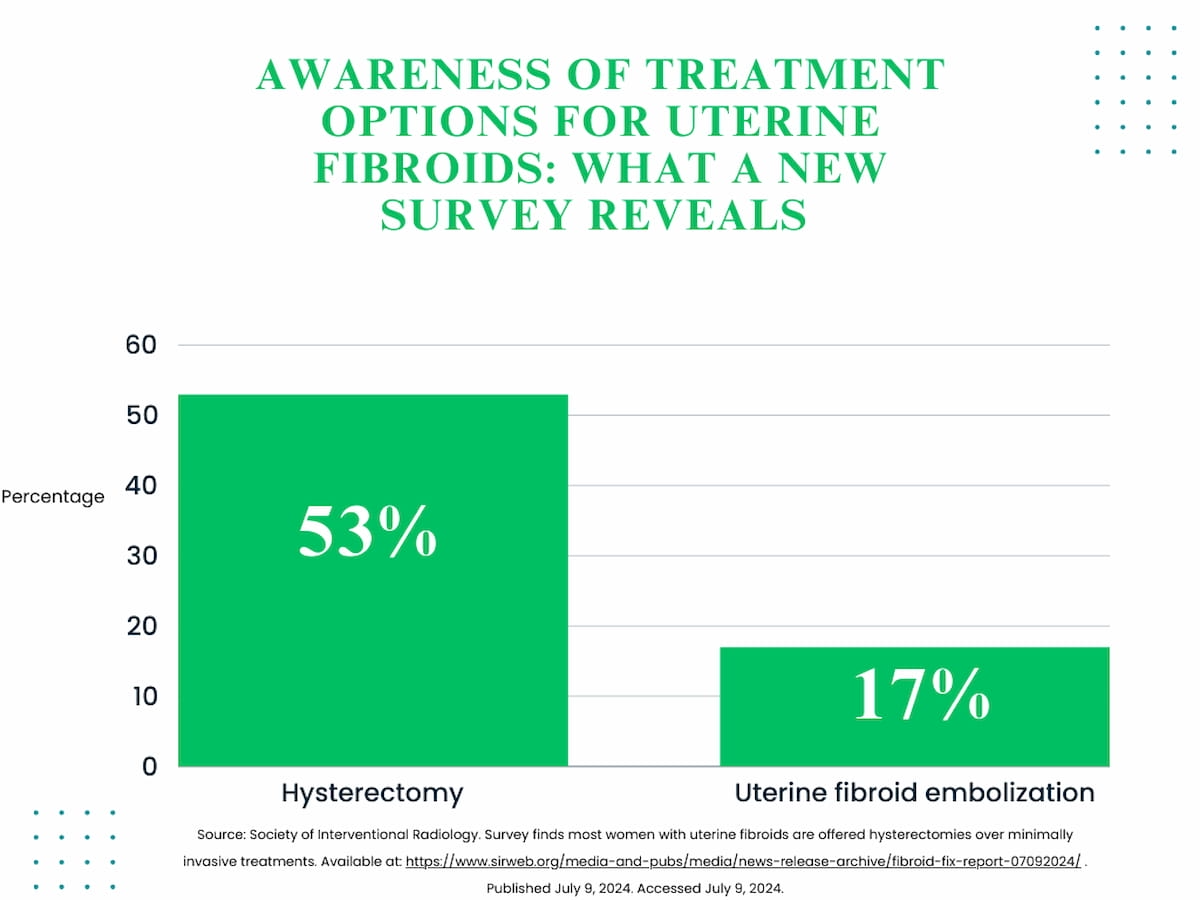Survey Shows Lack of Awareness for Uterine Fibroid Embolization Procedure Commonly Performed by Interventional Radiologists
New survey findings show that over half of the female respondents were unaware of uterine fibroids and less than 20 percent of women diagnosed with the condition received information about less invasive treatment options such as uterine fibroid embolization.
While more than 75 percent of women will have uterine fibroids in their lifetime, new survey findings reveal a lack of awareness about minimally invasive treatment options and that hysterectomy was presented as a treatment for over half of women diagnosed with uterine fibroids.
Over 50 percent of women between the ages of 18 and 44 were not familiar or had not heard of uterine fibroids, according to the online survey of 1,122 women conducted by the Harris Poll on behalf of the Society of Interventional Radiology (SIR).1
Of the 167 survey respondents who had been diagnosed with uterine fibroids, less than 20 percent received information about less invasive treatment options ranging from over-the-counter NSAIDs and oral contraceptives to uterine fibroid embolization (UFE), a procedure commonly performed by interventional radiologists.1
While 53 percent of women diagnosed with uterine fibroids were presented with hysterectomy as a treatment for the condition, only 17 percent were told about uterine fibroid embolization, according to a recent survey commissioned by the Society of Interventional Radiology (SIR).

“The survey findings, coupled with the low number of women who were offered a minimally invasive treatment like UFE, indicate that women are not being given all of the information they need to make their own health-care decisions,” noted John C. Lipman, M.D., FSIR, the founder and medical director of the Atlanta Fibroid Center in Georgia. “Not offering minimally invasive treatments like UFE in addition to the surgical treatment options is a significant oversight.”
Noting that several studies have demonstrated the effectiveness of UFE, SIR emphasized that 90 percent of those who undergo UFE have significant relief from uterine fibroids or complete resolution. For women who are familiar with UFE, only 40 percent learned about the treatment option from physicians, according to the survey.1
While research has shown a threefold higher risk of uterine fibroids among Black women and double the risk for Hispanic women, the survey findings revealed that 36 percent of Black respondents and 22 percent of Hispanic respondents don’t believe they are at risk for the condition.1,2 Survey findings also showed that half of Hispanic respondents and 37 percent of Black respondents were not aware of uterine fibroids.1
“The survey noted deep disparities in awareness and access regarding fibroids and fibroid treatments among Black and Hispanic women, who have a higher risk factor for developing uterine fibroids,” pointed out Robert J. Lewandowski, M.D., the president of SIR, and professor at the Northwestern University Feinberg School of Medicine. “The data serve as a guiding light for improving physician and patient educational efforts on various treatments to ensure all women, regardless of background, are informed about their risks and the full range of treatment options available.”
References
1. Society of Interventional Radiology. Survey finds most women with uterine fibroids are offered hysterectomies over minimally invasive treatments. Available at: https://www.sirweb.org/media-and-pubs/media/news-release-archive/fibroid-fix-report-07092024/ . Published July 9, 2024. Accessed July 9, 2024.
2. Catherino WH, Eltoukhi HM, Al-Hendy A. Racial and ethnic differences in the pathogenesis and clinical manifestations of uterine leiomyoma. Semin Reprod Med. 2013;31(5):370-379.
The Reading Room: Racial and Ethnic Minorities, Cancer Screenings, and COVID-19
November 3rd 2020In this podcast episode, Dr. Shalom Kalnicki, from Montefiore and Albert Einstein College of Medicine, discusses the disparities minority patients face with cancer screenings and what can be done to increase access during the pandemic.
What New Research Reveals About Novice Use of AI-Guided Cardiac Ultrasound
April 4th 2025In a study recently presented at the American College of Cardiology (ACC) conference, researchers found that novice use of AI-guided cardiac ultrasound after an AI-enabled electrocardiogram increased the positive predictive value for reduced left ventricular ejection fraction (LVEF) or aortic valve stenosis by 33 percent.
New AI-Enabled Portable Ultrasound May Facilitate 50 Percent Reduction in Cardiac Imaging Scan Time
March 28th 2025Artificial intelligence (AI)-powered measurement capabilities provide key features with the Compact Ultrasound 5500CV device, which was unveiled at the American College of Cardiology (ACC) conference.